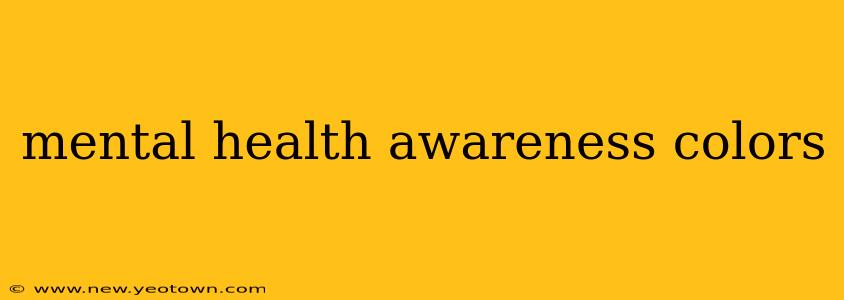The vibrant tapestry of life often masks the quiet struggles many face with their mental health. But just as a single thread contributes to the richness of the whole, individual stories of resilience and recovery weave together to form a powerful movement. And within this movement, color plays a significant role, symbolizing hope, solidarity, and the ongoing conversation about mental well-being. Let's delve into the world of mental health awareness colors and the powerful messages they convey.
What are the main colors associated with mental health awareness?
While there isn't one single universally accepted color for mental health awareness, green is often prominently featured. Think of the calming effect of nature, the feeling of renewal that comes with springtime – green symbolizes growth, healing, and hope. It represents the potential for recovery and the continuous journey towards better mental health. However, many other colors also contribute to the overall representation of mental health awareness, often used in conjunction with green or independently for specific causes or campaigns. For example, certain shades are adopted to represent specific mental illnesses.
What color represents mental health awareness month?
Mental Health Awareness Month, celebrated every May, doesn't have a single designated color. Instead, the month is typically represented by a variety of colors reflecting the broad spectrum of mental health conditions and experiences. Green, yellow, and even purple are all frequently seen during this period, emphasizing the diverse nature of mental wellness.
What color is used for suicide prevention?
While various colors might be used in different suicide prevention campaigns, yellow is often associated with suicide awareness and prevention efforts. This vibrant hue can represent optimism and a brighter future, serving as a powerful reminder that help is available and recovery is possible. It also contrasts with the often-depressing themes surrounding suicide, offering a visual symbol of hope in the face of despair.
What color ribbons represent mental health?
Ribbons are a powerful visual symbol in awareness campaigns, and those representing mental health often feature a variety of colors. A green ribbon is commonly seen, reflecting the broader themes associated with mental well-being. However, the color of the ribbon can sometimes be specific to a particular mental health condition or organization. This variability in color reflects the wide range of mental health challenges and the specific needs of different communities.
What are some other colors associated with mental health?
Beyond green and yellow, several other colors are utilized in mental health awareness initiatives. Orange, for example, can represent creativity and energy, symbolizing the strength and resilience needed to navigate mental health struggles. Blue can represent peace and tranquility, reflecting the importance of self-care and finding moments of calm amidst challenges. Purple is frequently associated with specific mental health conditions and organizations. The use of multiple colors highlights the complexity and diversity of mental health experiences.
The Power of Color in Raising Awareness
The use of color in mental health awareness campaigns isn't simply an aesthetic choice. It's a strategic tool used to foster recognition, encourage open dialogue, and ultimately, save lives. By connecting powerful visual imagery to complex and often sensitive topics, awareness campaigns use color to bridge the gap between silence and understanding, fostering a more supportive and inclusive environment for individuals grappling with mental health challenges. The spectrum of colors used reflects the broad spectrum of experiences within mental health, highlighting the need for diverse and inclusive support systems. The message is clear: you are not alone.

